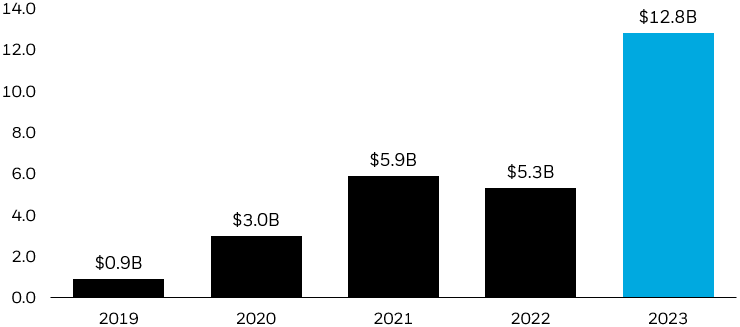- Recent clinical trial success for the second significant, disease-modifying drug to treat Alzheimer’s is a critical milestone and a positive sign for the future of neuroscience.
- Technological advancements, particularly artificial intelligence (AI), are supercharging medical breakthroughs with smarter drug discovery, faster development, increased diagnostic accuracy, and higher industry output.
- Secular trends, such as aging demographics, medical technology innovation, plus cyclical factors, such as favorable valuations, may create attractive long-term opportunities in neuroscience and AI.
Finding investment opportunities in neuroscience and AI
Jul 09, 2024 Industry
KEY TAKEAWAYS
A CRITICAL MILESTONE FOR ALZHEIMER’S TREATMENTS
Since we published our neuroscience theme primer in August 2022, we have seen extraordinary advances in Alzheimer’s treatments. Clinical trials from July 2023 for the experimental drug donanemab showed the drug slowed cognitive decline in Alzheimer’s patients by 29%.1 In June 2024, an FDA advisory panel unanimously voted that the drug effectively slows Alzheimer's progression in early-stage disease and that its benefits outweigh its risks — and while this decision alone does not represent approval of the drug, the FDA is expected to act on the recommendation of its advisory panel in the coming months.2 Following on the heels of comparable results for a similar antibody, lecanemab, this outcome bolsters the long-held — but once contested — hypothesis that preventing the accumulation of a protein called beta amyloid (“plaque”) in the brain could help the many millions afflicted with the disease. After almost 20 years without new Alzheimer’s drugs, this news represents a potential shift in how patients may be treated in the future.
Beyond donanemab and lecanemab, there are a range of disease-modifying drugs in clinical development that could help address the significant unmet needs of those with dementia and other neurocognitive disorders. Neurology is expected to see the fourth-most drug spending across therapeutics, potentially reaching $169 billion by 2027.3 Alzheimer’s is the largest area of focus within neurology drug research — followed by Parkinson’s and epilepsy.4
Neurology research is focused on Alzheimer’s
Number of products in neurology Phase I – III trials by disease, 2019 – 2023

Source: Citeline Trialtrove, Jan 2024; IQVIA Institute, Jan 2024. Note: Analysis includes trials started 2019-2023 with open, closed and temporary closed. Trials for more than one indication may be included in more than one disease area.
Chart description: Column chart showing the number of products in neurology Phase I to Phase III trials from 2019 - 2023 by disease. The chart shows that neurology research is focused on Alzheimer's disease.
ARMING NEUROSCIENCE COMPANIES WITH AI
AI adoption in neuroscience is rapidly improving with progress across drug research & development (R&D), diagnostics and our understanding of the brain itself. Over $12B in life sciences deals with AI or machine learning were announced in 2023 — including a $3M deal between Shape Therapeutics and Roche to develop gene therapies for neurodegenerative diseases.5
AI-driven research is growing — with over $12B in deals announced in 2023
Value of life sciences deals ($B) involving AI from 2019-2023

Source: IQVIA Pharma Deals, Dec. 2023.
Chart description: Column chart showing the value of life sciences deals with AI-involvement from 2019 – 2023. The chart shows that the value of deals in 2023 is more than double the level in the prior two years — and almost nine times higher than in 2019.
R&D capabilities, including smarter drug discovery and development, are being advanced by machine learning, large data sets and generative AI, which can have human-like conversations, create content, images and audio. Researchers can now use computing power to identify clinically meaningful patterns in data with efficient AI algorithms.6 These technologies have helped to shorten early drug development timelines. In fact, scientists might be able to develop drugs in one-tenth of the time.7
Diagnostic accuracy also continues to improve. A team at Massachusetts General Hospital used deep learning, a type of machine learning and AI that utilizes large amounts of data and complex algorithms to train models that test for Alzheimer’s based on data from brain MRIs collected from patients with and without the disease. The model was tested on tens of thousands of routine brain scans and spotted disease risk with 90% accuracy.8
AI is even helping scientists better understand the inner workings of natural brains. Artificial neural networks (ANNs), while not designed to mimic human brains, are exhibiting similar “thinking.” For example, the interpretation of visual stimuli in the human brain builds up neuron by neuron — first distinguishing shapes, then colors and so on “until eventually, the brain decides whether it is looking at a car, a dog or banana...”, as described in an article published by The Economist.9 Surprising brain and machine learning researchers alike, AI is taking virtually the same approach when tasked with identifying visual cues. Similarities are also appearing in speech and language processing, as ANNs digest more data with ever greater processing power. This is a gamechanger for better understanding human brains and allowing the human brain to be directly linked to machines; for example, potentially returning eyesight or motor control to the handicapped.
A CASE FOR HEALTHCARE STOCKS
Erin Xie, head of the Health Sciences team in BlackRock's Active Equity Group emphasizes that “over the long-term, [we] are seeing secular drivers for the sector remain in place; firstly, aging demographics in both developed and developing countries and secondly, innovation in medical technology.” Her team is seeking opportunities in healthcare segments with attractive valuations, stable growth, and promising product pipelines for selective growth opportunities in biotech, pharmaceuticals, and medical devices.
The rising interest rate environment beginning in early 2022 has negatively affected many smaller cap healthcare companies, often the purest players in areas like neuroscience, making it challenging for them to fund development in the short-term. This dynamic has brought down valuations and therefore created an attractive mergers and acquisitions (M&A) environment that has the potential to drive significant returns for acquirees and could present an attractive entry point for investors across the space. An end of the Federal Reserve’s rate-tightening cycle may also create a better financing backdrop, potentially spurring a prolonged rotation back into the space and encouraging a general reopening of capital markets activity in the biotechnology sub-sector.
Over the long term, there could be an inherent secular tailwind for healthcare, driven by demographic mega forces related ageing global populations with inelastic demand for the healthcare products and services. For example, adults aged 65 and older currently make up almost 20% of the U.S. population10 and spend three times more on healthcare services than younger demographics.11
CONCLUSION
The concurrent trends of groundbreaking medical innovation and AI advancements come together to create a strong, long-term case for neuroscience. In the short term, favorable M&A dynamics and attractive valuations, coupled with structural demographic mega forces, suggest that neuroscience may be well-positioned for growth. Investors seeking exposure to advances in neuroscience and AI may want to consider looking to active and index ETFs to potentially capture the opportunity.

